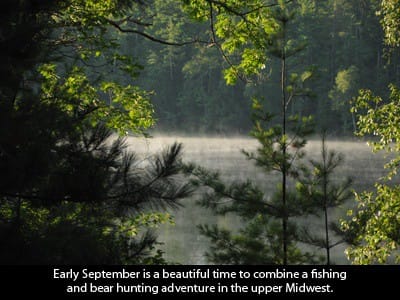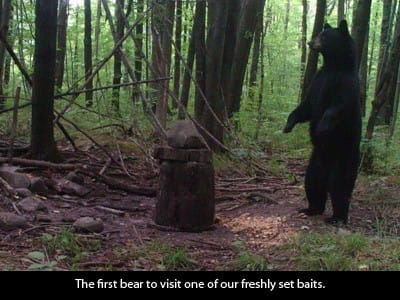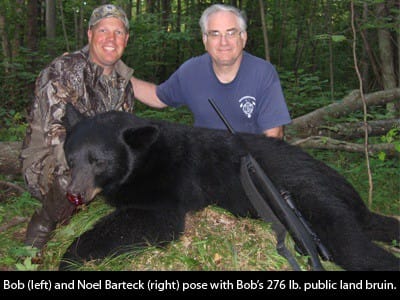By Bob Barteck, IAFF Local 425 Alumni

The sun filtering through the maple leaves turned the forest floor to amber. Perched high in an old basswood, my brother, John, and I enjoy a flurry of activity. Birds call and flutter past as squirrels rummage for the upcoming winter. I’m lulled into a trance when John pokes me. My eyes strain for what he’s seen in the deep timber. Suddenly, a shadow steps forward to reveal the jet black coat of our quarry. I hear John click on the video camera as I pull up my binoculars. A few minutes later, the small bear is at the base of our tree curiously staring up at us.
He began a parade of five bears visiting our bait site that evening. They weren’t the bears we were looking for, but we weren’t complaining. Five days of watching and waiting paid off when the bear I wanted made a fatal mistake.
Early September in the upper Midwest brings beautiful, warm days followed by cool nights. The aspens turn gold, the whitetail lose their velvet, and the black bears are on their feet, packing in calories.
For my family, it’s a time to celebrate the start of bear season. With rare exception, one of our family members or close friends draws a Wisconsin Unit C Bear Kill Permit. Our hometown in Wisconsin’s Clark County is close to thousands of acres of public land intermingled with farmlands full of corn and soy beans. The combination is perfect for the bears and, over the last 20 years, the bear population has exploded.
While I’d never claim to be an expert, my brother and I have killed our share of bears and helped a few friends kill good bears too. Our area of expertise is using bait sites to draw bears out of the dense forest. It gives the DIY hunter the best chance for a successful hunt. Here’s a list of tips and tactics to help you get started on a successful DIY bear hunt:
Choose a Destination: Wisconsin, Michigan and Minnesota offer fantastic bear hunting opportunities. With national forests, state and county lands, they’re home to some of the best public access hunting in the country. Plus, each state has pro¬grams that open private lands for public hunting. A visit to the states’ Web sites will reveal a number of options. Each state has a unique draw system for kill permits. In Wisconsin, residents and non-residents are entered into the same preference point draw system. Applicants can expect to wait four to eight years for a tag. Minnesota and Michigan have weighted draw systems that tend to have a shorter wait.

Picking the Perfect Location: When looking for a place to establish a bait site, examine aerial photos. Look for large, continuous tracts of land with a mix of swamp or low land and higher upper ground. If possible, pick a spot with corn or soybean fields nearby. Bears eat the soy beans through the summer and move into the corn fields as the corn ripens. Baiting close to those food sources will increase the likelihood that bears will continue to visit your bait even when feeding on crops.
The best hunting spots will be where thick underbrush opens to more open high grounds. Bears love thick cover to conceal their daytime movement. They’re very nocturnal, so place bait in a location that capitalizes on daytime movements. The stand and bait site should both be considered when picking a location. Using the prevailing west to northwest wind, we place the stand to the southeast of the bait.
Hunting on public land demands being discrete about your bait locations. Park off main roads, keep foot paths to the bait as concealed as possible and leave your quad at home until you need to retrieve your bear. Typically, the farther you’re willing to walk, the more private your hunting spot will be.
Baiting: We begin baiting in mid-July and have the bears conditioned to visit our buffet line by the time hunting season rolls around. If you’re under a short time line, it’s possible to establish and hunt over a bait site at the same time. Just use strong attractant scents and play the wind.
We use a mix of candy, cereal, crackers and chocolate from a local bear bait supplier. Place the bait in a hollowed stump with a cover and heavy rock to keep raccoons out. To help attract bears, pour filtered fryer grease from local restaurants on the ground around the bait. The bears’ paws get covered in the grease as they wander away, leaving a heavy scent trail that leads other bears to your bait.
Inventory: We place well protected cameras at each bait site. Bears are curious and love to use cameras as chew toys, so protect your investment with a good steel or wood box. When baiting, change the SD card and download all the pictures organized by bait site. Measure your bait stump and/or nearby logs to use as a size reference. After a short time, you’ll recognize the bigger bears and develop a list of potential shooters.

Time to Hunt: We don’t hunt in the mornings because we’ve spooked too many bears trying to sneak in before daylight. Instead, we fish in the morning and keep our hunts to long afternoon sits. When the first jet black bruin arrives, be patient and study it. Be alert for cubs. It’s unethical to kill a sow with cubs. Judge the bear’s size by comparing it to the size of your bait stump.
Making the Shot: Understanding the anatomy of a black bear is necessary for a clean and ethical kill. A black bear’s heart lies more forward and lower than a deer. Due to the large amounts of loose and greasy fat, wounded bears don’t leave a huge blood trail. Be patient and wait for a broadside shot with the near leg forward. Aiming at the middle mass 3 to 4 inches behind the near leg will produce a double lung shot and a short tracking job.
Research, planning and hard work pay off on any public land hunt, and bear hunting is no different. The reward is not just the bear rug on the wall; it’s also a freezer full of bear meat and many cherished memories. Bear hunting is affordable and probably closer than you think, but once you try it, you’ll be hooked for life!
The Union Sportsmen’s Alliance website is designed to provide valuable articles about hunting, fishing and conservation for members of AFL-CIO affiliated labor unions and all sportsmen and sportswomen who appreciate hunting and fishing and want to preserve our outdoor heritage for future generations. If you would like your own story and experience from the outdoors to be considered for our website, please email us at USAmembers@unionsportsmen.org.
You might also be interested in these articles:
Bear Backdrop
Bear Country
The Bear Lord



